The monsoon season brings relief from scorching summer heat, but it also ushers in a time when our bodies become more susceptible to seasonal ailments. According to Ayurveda, the ancient Indian system of medicine, the monsoon period corresponds to the dominance of Vata dosha, characterised by increased humidity, dampness, and weakened digestive fire (agni). During this time, our immunity naturally dips, making us more prone to infections, digestive issues, and respiratory problems. These dishes share common Ayurvedic principles that make them particularly suitable for monsoon consumption. They emphasise warm, cooked foods over raw preparations, use digestive spices to support weakened agni, and incorporate ingredients with natural antimicrobial and anti-inflammatory properties. The focus on easily digestible ingredients helps prevent the accumulation of ama (toxins) that can occur when digestive fire is low. Additionally, these dishes provide adequate nutrition without being heavy, helping maintain energy levels whilst supporting the body’s natural healing processes. Fortunately, Indian culinary wisdom offers a treasure trove of dishes specifically designed to combat these seasonal challenges. These time-tested recipes not only satisfy the palate but also strengthen the body’s natural defences through carefully selected ingredients that align with Ayurvedic principles. Here are seven regional Indian dishes that can help build monsoon immunity whilst keeping you warm, nourished, and healthy during the rainy season. 1. Gujarati Khichdi This humble yet powerful dish from Gujarat exemplifies the Ayurvedic principle of eating light, easily digestible foods during monsoon. The combination of rice and split yellow moong dal creates a complete protein whilst being gentle on the digestive system. The addition of turmeric provides anti-inflammatory and antimicrobial properties, whilst ghee enhances absorption of fat-soluble vitamins and provides healthy fats essential for immunity. The warming spices typically used cumin, ginger, and hing (asafoetida) help kindle the digestive fire and reduce Vata imbalance. This dish is particularly beneficial during monsoon as it provides sustained energy without taxing the digestive system, which tends to be weaker during this season. 2. Kerala’s Rasam Hailing from South India, rasam is a tangy, spiced soup that serves as both comfort food and medicine. The traditional Kerala version combines tamarind’s sourness with the heat of black pepper and the aromatic essence of fresh curry leaves. Black pepper is particularly valuable during monsoon as it stimulates circulation, aids digestion, and helps clear respiratory congestion. The curry leaves provide essential vitamins and minerals whilst offering antimicrobial benefits. Turmeric and coriander seeds add their healing properties, making this dish a powerhouse for building immunity. The liquid consistency also helps maintain hydration levels, which can be challenging during the humid monsoon period. 3. Maharashtrian Zunka Bhakri This rustic dish from Maharashtra combines besan (gram flour) zunka with bhakri (millet flatbread) and a touch of jaggery. Besan is rich in protein and has a naturally warming effect on the body, making it ideal for monsoon consumption. The dish is typically prepared with onions, green chillies, and turmeric, all of which contribute to its immunity-boosting properties. Jaggery serves as a healthier alternative to refined sugar whilst providing iron and other minerals. According to Ayurveda, jaggery helps balance Vata dosha and supports respiratory health particularly important during the damp monsoon months when respiratory issues are common. 4. Bengali Shukto Bengal’s traditional mixed vegetable curry, shukto, is a perfect monsoon dish that incorporates bitter gourd, drumstick, sweet potato, and other seasonal vegetables. The bitter taste (tikta rasa) is particularly beneficial during monsoon as it helps purify the blood and supports liver function, which can become sluggish during this season. Fresh ginger paste forms the base of this curry, providing warmth and digestive support. The light mustard oil used in Bengali cooking has antimicrobial properties and helps maintain body temperature. The variety of vegetables ensures a broad spectrum of vitamins and minerals essential for maintaining immunity. 5. Rajasthani Dal Baati Churma This hearty dish from Rajasthan provides the robust nutrition needed during monsoon. The dal is rich in protein and B vitamins, whilst the baati provides complex carbohydrates for sustained energy. The generous use of ghee not only enhances flavour but also provides essential fatty acids that support immune function. The traditional spices used red chilli, coriander, and cumin have warming properties that help maintain internal heat during cool, damp weather. Churma, made from crushed baati mixed with jaggery and ghee, provides quick energy and helps satisfy sweet cravings in a healthier manner. 6. Tamil Nadu’s Sambar This South Indian staple combines multiple lentils with vegetables like drumstick, okra, and brinjal, creating a nutritionally dense dish perfect for monsoon consumption. Drumstick pods are particularly valuable as they’re rich in vitamin C, iron, and antioxidants that support immune function. The sambar powder, made from roasted spices including fenugreek, coriander, and red chillies, provides warming qualities essential during monsoon. The tamarind adds beneficial organic acids that aid digestion, whilst curry leaves contribute their distinctive flavour and medicinal properties. 7. Himachali Madra From the hills of Himachal Pradesh comes madra, a creamy curry made with chickpeas or kidney beans cooked in yoghurt and warming spices. The probiotics in yoghurt support gut health, which is crucial for maintaining immunity. The combination of cardamom, cloves, and cinnamon provides antimicrobial benefits whilst helping to balance the cool, damp qualities of monsoon. This dish exemplifies the mountain wisdom of using warming spices and dairy products to maintain internal heat and nutrition during challenging weather conditions. The high protein content from legumes helps maintain energy levels and supports immune function.
